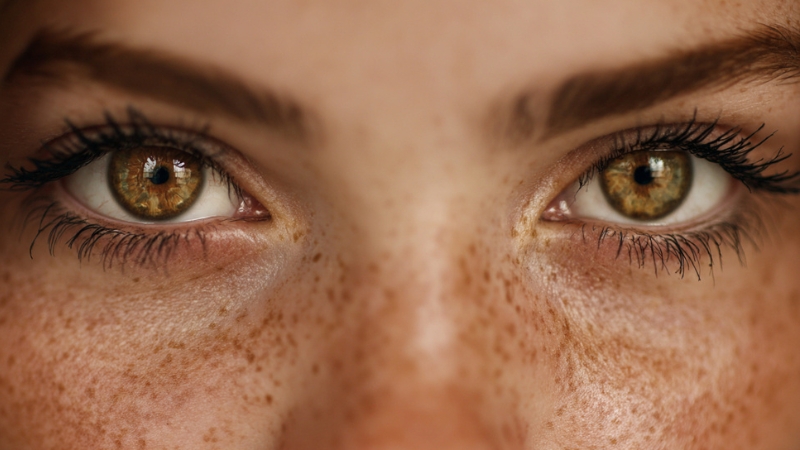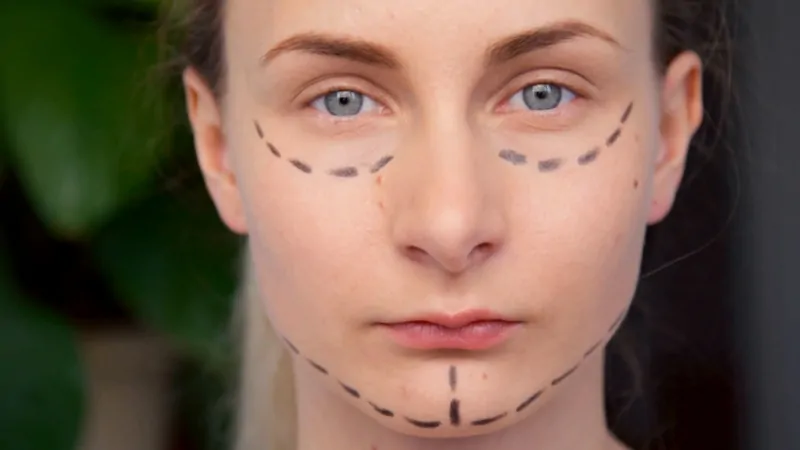Hazel eyes get a lot of attention, partly because they’re genuinely uncommon. Only about 5% of people worldwide have them.
When I first learned that, it suddenly made sense why hazel eyes always stood out a bit in my own circles; they’re rare enough to catch your eye, but not so rare that you never see them.
Globally, brown eyes dominate, showing up in roughly 70% to 79% of people according to Medical News Today.
Blue eyes come in at about 8% to 10%, while green eyes, often talked about as the “most beautiful,” are truly rare at only around 2%. Gray and amber hover somewhere between 3% and 5%, depending on how researchers classify them.
The U.S. is a different story. Because of its mix of European ancestry, hazel eyes appear in about 18% of Americans, which is several times higher than the global average.
That blend of common and rare is exactly what makes hazel eyes so interesting, both genetically and culturally; they sit in a category all their own.
Table of Contents
ToggleGlobal Eye Color Prevalence
Eye Color
Estimated Global %
Common Regions
Melanin Level
Structural Notes
Brown
70%–79%
Africa, Asia, Latin America, Southern Europe
High
Uniform pigmentation, minimal light scattering
Blue
8%–10%
Northern & Eastern Europe (especially Scandinavia, Baltic)
Low
Rayleigh scattering creates a blue hue
Hazel
~5%
U.S., parts of Europe, the Middle East, and Brazil
Medium
Mixed pigmentation and scattering; variable under lighting
Amber
~5%
South America, the Middle East, and parts of Asia
Medium–High
High pheomelanin content gives a golden tone
Gray
~3%
Eastern Europe, the Baltics, and Russia
Very Low
Tyndall scattering; less studied
Green
~2%
Ireland, Scotland, Iceland, Germany
Low
Minimal melanin + high lipochrome presence
Hazel eyes are grouped among intermediate eye colors and are frequently misclassified, either as light brown, amber, or even green due to their multicolored and shifting appearance.
This often causes underreporting or variability in the data, depending on the classification system used.
United States Eye Color Distribution – More Than Just Brown and Blue
The United States is one of the most ethnically diverse countries in the world, and this diversity is reflected in the range of eye colors found across the population.
Unlike much of the globe, where brown eyes overwhelmingly dominate, the U.S. shows a more even spread due to centuries of immigration from Northern, Southern, and Eastern Europe, as well as Latin America, Asia, and the Middle East.
According to data compiled by sources including the American Academy of Ophthalmology, National Institutes of Health (NIH), and large-scale consumer surveys (such as those by YouGov and All About Vision), the distribution of eye color in the U.S. can be broken down as follows:

Hazel eyes show up far more often in the United States than they do globally. They’re the third most common eye color among Americans and appear in almost one out of every five people. When I first came across that number, it explained why hazel eyes felt so familiar growing up, even though they make up only about 5% of the world’s population.
They’re especially common among people with European or Middle Eastern ancestry. Among non-Hispanic white Americans in particular, both hazel and green eyes appear more frequently because of polygenic inheritance and centuries of genetic mixing across different parts of Europe.
Regional patterns add another layer. In the Midwest and Northeast, you see more blue and green eyes; in the South and Southwest, brown and hazel dominate. It’s one of those subtle demographic clues you don’t really notice until someone points it out.
A 2024 YouGov America survey found that hazel eyes were self-reported more often by women (20%) than men (16%). Whether that reflects genuine differences or simply how people describe their own eye color is hard to say, but the gap shows up consistently in survey data.
Genetic Complexity of Hazel Eyes: Why They Are Rare and Variable
Hazel eyes don’t come from a single “hazel gene.” They’re a polygenic trait, which means several genes work together to shape the final color.
When I first learned that, it made sense why hazel eyes look so different from one person to the next; there isn’t one genetic switch that turns them on or off.
Genes like OCA2, HERC2, TYR, and SLC45A2 all play a role in deciding how much melanin ends up in the iris and how that pigment is distributed, according to PMC. Melanin is the same pigment responsible for our skin and hair color, and tiny changes in how it’s produced or organized inside the eye can shift the final shade.
What sets hazel eyes apart is that they sit right in the middle of the melanin spectrum. They have more pigment than blue eyes, but less than brown. That intermediate level, combined with the way light scatters inside the iris, through effects like Rayleigh and Tyndall scattering, creates those shifting tones.
A yellow pigment called lipochrome also adds a subtle golden or greenish tint, which is why hazel eyes can look warm in sunlight and cooler in the shade.
This results in a multicolored iris that may contain:
This complexity means that two hazel-eyed parents may produce children with green, blue, brown, or hazel eyes, depending on the interaction of their genes.
No single eye color inheritance chart can reliably predict hazel eyes due to the polygenic nature and the influence of modifier genes.
Regional Variation: Where Hazel Eyes Occur Most Frequently
Region
Hazel Eye Frequency
Contributing Factors
United States
~18%
Mixed European ancestry, especially Irish, Spanish, Italian, and German
Middle East (e.g., Lebanon, Iran, Turkey)
~10%–15%
Historical blend of Arab, Persian, and Mediterranean populations
Brazil & Argentina
~10%
Portuguese, German, Italian, and Arab ancestry
Western Europe (France, Spain, UK)
~8%–12%
Overlap of northern (blue-eyed) and southern (brown-eyed) genetics
North Africa (Morocco, Algeria)
~5%–10%
Berber, Arab, and southern European mix
According to population studies and genetic research, hazel eyes are most commonly found in countries where northern European, Mediterranean, Middle Eastern, and North African lineages have blended over time.
In the United States, about 18% of people are estimated to have hazel eyes—much higher than the global average of around 5%. This is largely due to the country’s diverse ancestry, particularly among people with Irish, German, Spanish, Italian, and Middle Eastern roots.
According to the American Academy of Ophthalmology, hazel is the third most common eye color in the U.S., after brown and blue.
In the Middle East, hazel eyes are also relatively frequent, with estimated rates between 10% and 15% in countries like Lebanon, Iran, and Turkey. This is likely due to the region’s long history of migration and intermarriage among Arab, Persian, and Mediterranean populations.
Genetic variation in this region supports a wider range of phenotypes, including light and mixed eye colors.
Brazil and Argentina also show a noticeable presence of hazel eyes,roughly 10% of the population, thanks to immigration from Europe, particularly Portugal, Spain, Germany, and Italy. These countries also have smaller but influential communities of Middle Eastern descent, which further contribute to eye color diversity.
In Western Europe, especially in places like France, the UK, and Germany, hazel eyes are seen in about 8% to 12% of the population.
This reflects a natural blending between traditionally blue-eyed northern Europeans and darker-eyed southern populations.
In contrast, regions with more genetic homogeneity, such as East Asia and sub-Saharan Africa, show very low rates of hazel eyes, with brown being almost universally dominant.
Studies in human genetics confirm that where populations have mixed across multiple continents and ethnic lines, traits like hazel eyes tend to appear more often.
Psychological and Social Perception of Hazel Eyes
@drrupawong Hazel eye facts 👀💚💛🤎 Do you have hazel eyes? How does your eye color change? #hazeleyes #eyedoctor #eyecolor #greeneyes #ophthalmology #eyecolour ♬ where is my mind (piano version) – your movie soundtrack
It’s interesting how often hazel eyes show up near the top of attractiveness polls. Several psychology studies, including ones indexed on PubMed, suggest that people tend to rate hazel and green eyes as more “unique” or “mysterious.”
I’ve always wondered if part of that comes from how hazel eyes change in different lighting; they almost never look exactly the same from one moment to the next, and people seem to pick up on that.
Media and pop culture definitely play a role, too.
Hazel eyes are frequently described as rare or exotic, and that reputation only grows when well-known actors and public figures have them.
Kristen Stewart, Tyra Banks, Ben Affleck, and David Beckham all get pointed out for their hazel eyes, which keeps the color visible and, in a way, culturally amplified.
Whether it’s the rarity, the shifting tones, or the celebrity association, hazel eyes tend to leave a strong impression, and the research seems to back up that instinct.
Hazel Eyes vs. Other Ambiguous Eye Colors
Because hazel eyes often share characteristics with amber, green, and light brown, it’s important to understand the scientific differences between them. Here’s a more technical breakdown:
Feature
Hazel Eyes
Amber Eyes
Green Eyes
Light Brown Eyes
Base Pigment
Moderate melanin + lipochrome
High pheomelanin (yellow pigment)
Low melanin + high lipochrome
High melanin, no scattering
Color Variability
High (depends on lighting)
Low (solid golden tone)
Moderate
Low
Structural Scattering
Present
Minimal
Strong (Rayleigh effect)
Absent
Classification Issues
Often confused with brown/green
Often confused with hazel
Confused with hazel
Often misidentified as hazel
Many eye color apps and online surveys do not distinguish well between these colors, leading to inconsistent reporting in large datasets. Clinical classification usually relies on iris photographs under neutral lighting.
Methodology
To put this article together, I relied on a mix of scientific literature, population genetics research, and large-scale survey data. The goal was to balance hard numbers with real-world context, so the information reflects both the biological mechanisms behind hazel eyes and the demographic patterns seen in different parts of the world.
I started with peer-reviewed studies from sources like PubMed and PMC, focusing on pigmentation genetics, iris structure, and the polygenic traits that influence eye color. Research from the National Institutes of Health (NIH) and the American Academy of Ophthalmology provided the backbone for understanding melanin distribution, scattering effects, and gene interactions such as OCA2, HERC2, TYR, and SLC45A2.
For prevalence numbers, I cross-checked data from multiple places to avoid relying on a single dataset. This included global estimates from Medical News Today, demographic records from genetic studies, and U.S.-specific insights from YouGov, All About Vision, and ophthalmology organizations. When different sources offered slightly different percentages, I leaned on the midpoint values supported across several studies.
I also reviewed regional population trends, especially in the U.S., the Middle East, Western Europe, and Latin America, to understand how centuries of migration and genetic mixing shaped where hazel eyes appear most today.
Final Thoughts

Hazel eyes are a unique product of genetics, migration, and evolution. They represent more than just an intermediate point on the eye color spectrum; they are a marker of genetic diversity, particularly in populations that have seen centuries of admixture.
Genetic traits like eye color can also intersect with broader topics in heredity, such as the most common birth defects in the U.S., many of which have genetic components.
Their rich, multicolored appearance makes them both biologically and culturally significant. While they may not be the rarest, hazel eyes remain one of the most variable and visually dynamic eye colors, defying simple categorization and revealing the complex interplay of human genetics.
If you’re one of the few with hazel eyes—or curious about your ancestry, their presence offers clues about your genetic heritage and adds a layer of individuality that’s truly worth appreciating.
References
- Medical News Today – Eye color percentage: How common are your eyes?
- American Academy of Ophthalmology – Your Blue Eyes Aren’t Really Blue
- National Institutes of Health (NIH) – The genetics of eye color
- YouGov America – Eye Colors Poll Results (2024 PDF)
- PMC (National Library of Medicine) – Genetic insights into pigmentation traits and eye color
Related Posts:
- Oregon’s Population Is Rising, but The Pace Has…
- Why the United States in 2050 Will Be Unrecognizable…
- US vs Europe Healthcare in 2025 - Costs, Quality of…
- 8 Eye-Opening Statistics on Mental Health Disorders…
- How Lighting Affects Mental Focus, Sleep, and Eye Health
- A Groundbreaking Eye Treatment Just Restored Vision…








